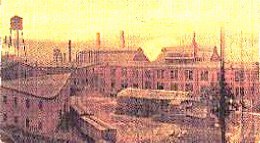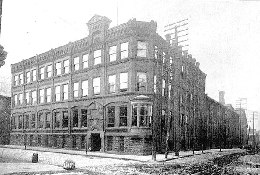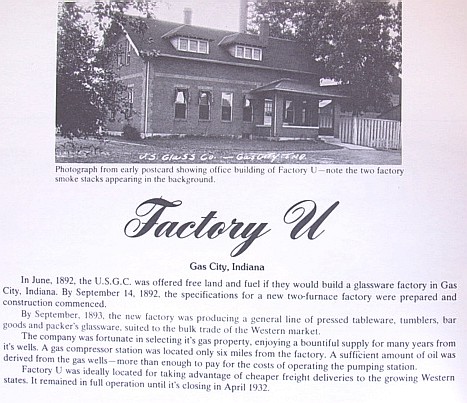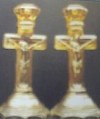Carnival Glass 101 | home Quick Reference to Carnival Glass Patterns
US Glass
 |
 |
U.S. Glass Co. at Glassport, PA (1912)
|
UNITED STATES GLASS CO.
Corporate Offices - Pittsburgh, PA
|
The Conglomerate: UNITED STATES GLASS COMPANY
Note: The kindness and generosity of Doris Bliss is acknowledged here! As a result of her interest and extensive research in 1997, when she contacted the Pittsburgh Carnegie Library for help in justifying her inquisitiveness concerning this glass company, we are all benefiting at this point in time. She forwarded that packet of information to us, for purposes of compiling this historic scenario. Evidence of another Carnival Glass (Class) act of sharing is displayed here. As we so often reiterate: It isn't the Glass, so much as it's the “chums” we come to know! The collectors are the best element in collecting!
MANY thanks….again, Doris! ~~~~~ Diane and Dean.
Story taken from The Pittsburgh Gazette Times, 1908
Founded in 1891, having a capital of $3,200,000 and operating eleven finely equipped plants, the United States Glass Company holds an enviable position among the industries of the Pittsburgh district. With factories in Pittsburgh, Glassport, Pa, Gas City, Ind., and Tiffin, Ohio, the company is able to take advantage of the most convenient of shipping facilities and largest deposits of natural gas, while it caters to the trade of the world through magnificent showrooms located in all the large cities of the United States, Mexico City, Mexico; London, England; Sydney, Australia; Havana, Cuba, and other centers of business.
This company manufactures pressed tableware, lead-blown stem ware, lead-blown tumblers, show jars, soda-fountain supplies, decorated ware (gold-etched, enameled, engraved and sand-blast), lamps, pressed stemware, pressed tumblers, pressed beer-mugs, confection-ware, novelties, private mild-work, photographers' goods, pavement lights, prism window-lights, wine sets, fancy-cut goods and other articles in glass.
A visit to the general office and salesrooms, Ninth and Bingham Streets, Southside, Pittsburgh, would be necessary to gather an adequate idea of what this company is doing. A floor space of 10,000 feet is devoted to the display of more than 20,000 different articles of glassware that are sold in every quarter of the globe. Odd shapes made for different countries are shown, and it might be said of the company that it makes glass for everything and everybody under the sun.
In each of the concern's eleven factories a certain class of ware is made, each force of workmen being trained to the highest skill in a particular branch of the trade. Special labor-saving machinery is used. The Tiffin, Ohio, and Gas City, Ind., plants are considered ideally located for cheap-freight deliveries to the West, while the Pittsburgh plants are most centrally placed to command easy access to the labor market. The Pittsburgh structures occupy ground worth from $2 to $6 a sq. foot which must be sold for other than factory uses in the near future. The company, to be ready for this contingency, has in reserve 500 acres of land on the Monongahela water front above McKeesport, Pa.
An army of men is given employment by the United States Glass Company, including a corps of trained salesmen who travel in all parts of the world, and a number of women and girls.
The officers are: President, D.C. Ripley, a man who knows the glass business from A to Z; Vice President, H.D.W. English; Secretary and Treasurer, W.C. King; Manufacturing manager, Wm. M. Anderson; Commercial Manager, M.G. Bryce
Story taken from The Crockery and Glass Journal, Dec. 28, 1882 in an article titled:
The Glass Pool ---- The End of an Era
The cartel was completed and took effect on July 1, 1891, as the United States Glass Company, with Daniel C. Ripley, Jr., as first president. The cover of the new company's catalogue gave the list of the new companies, each carrying an identifying letter by which it was to be known.
FACTORY KEY
Factories in blue indicate those still in operation after 1900
Adams & Co., Pittsburgh, PA
Bryce Brothers, Pittsburgh, PA
Challinor, Taylor & Co. Ltd., Tarentum, PA
George Duncan & Sons, Pittsburgh, PA
Richards & Hartley, Tarentum, PA
Ripley & Co., Pittsburgh, PA
Gillinder & Sons, Greensburg, PA
Hobbs Glass Co., Wheeling, WV
Columbia Glass, Findlay, OH
King Glass Co., Pittsburgh, PA
O'Hara Glass Co., Pittsburgh, PA
Bellaire Goblet Co., Findlay, OH
Nickel Plate Glass Co., Fostoria, OH
Central Glass Co., Wheeling, WV
Doyle & Co., Pittsburgh, PA
A. J. Beatty & Sons, Tiffin, OH
A. J. Beatty & Sons, Steubenville, OH
Novelty Glass Co., Fostoria, OH
|
Factory A
Factory B
Factory C
Factory D
Factory E
Factory F
Factory G
Factory H
Factory J
Factory K
Factory L
Factory M
Factory N
Factory O
Factory P
Factory R
Factory S
Factory T
|
OTHER GLASS FACTORIES BUILT BY U.S.G.C.
|
|
At Gas City, Indiana
At Glassport, PA (Factory O)
|
Factory U
Factory GP
|

Individual factory catalogues were absorbed and incorporated, often in toto, into the cartel catalogue, though the United States Glass Co., undoubtedly did not produce many of the single items and patterns it showed. It soon became apparent that the agreement to keep officers and executives at their posts made for an unwieldy organization; two years after the consolidation there was a purge of vice presidents. The cartel had not settled the companies' labor troubles. One of the Company's first demands was that the American Flint Glass Workers agree to lift all restrictions on output of their member-workmen. The union, of course, refused to give up a traditional right in the industry, and a three-year strike (1893-1896) followed. Both sides lost. The union gave in on the issues of restrictions on productivity and introduction of new labor-saving machinery and so lost much of its power. A number of companies closed by the strike never reopened, and the United States Glass Company itself never fully recovered from the losses it suffered in the strike.
Outbreak of hostilities with Spain was brought on by the sinking of the American battleship MAINE in Havana harbor on Feb 15, 1898. American public sentiment accused Spanish agents and war became inevitable. We mention this in order to fix the period in which the STATES patterns were produced. Prior to this outbreak with Spain, the States patterns Pennsylvania, Maryland, Ohio, Kentucky and Illinois were being produced in crystal with gold, and emerald with gold decoration. After this time, Dewey blue with gold was added to honor Admiral Dewey and the battle of Manila Bay.
The States patterns produced in Dewey blue with gold, were not popular and the production in this color was short lived. This is why blue pieces in any of the States patterns are rare today and difficult to find. The States patterns, Colorado, Massachusetts and Minnesota were first produced in 1898, worthy successors to the Ohio, Indiana, Kentucky, Maryland and Illinois patterns introduced in 1897.
As the result of a meeting held during the week of Sept. 4, 1899 in Pittsburg, Pa., the following glassware manufacturers agreed to the condition of consolidation and the National Glass Company was formed:
Rochester Tumbler Co., Rochester, PA
McKee Brothers, Pittsburgh, PA
Crystal Glass Co., Bridgeport, OH
Indiana Goblet & Tumbler, Greentown, IN
Model Flint Glass Co., Albany, IN
Cumberland Glass Co., Cumberland, MD
Greensburg Glass CO., Greensburg, PA
Riverside Glass CO., Wellsville, WV
Robinson Glass Co., Zanesville, OH
Royal Glass Co., Marietta, OH
Central Glass Co., Summitsville, IN
By November 1899, the following companies had also joined with the National Glass Company, making a total of nineteen factories:
Northwood Company, Indiana, PA
Keystone Tumbler Co., Rochester, PA
Dalzell, Gilmore & Leighton Co., Findlay, OH
Ohio Flint Glass Co., Lancaster, OH
West Virginia Glass Co., Martin's Ferry, OH
Canton Glass Co., Marion, IN
Beatty-Brady Glass Co., Dunkirk, IN
Fairmont Glass Co., Cumberland, MD
The following States patterns were first produced in 1900; Texas, Connecticut, Iowa, and New Jersey. A “Pineapple and Fan” wine set was brought out also in 1900, which was in demand for many years to come. It was first produced in crystal with gold decoration and emerald green with gold decoration.
The failure and dissolution of the combine by 1903 indicated the looseness of its organizational ties. The cartels mark the end of an era in American glass.
The Dunkirk Indiana Glass factory had been founded by George Brady and James Beatty in 1896. When the combine failed, the Dunkirk factory operated "unoffically" under the name of Indiana Glass Company until 1907 when it was "officially" purchased from the receivership. They still owned and maintained many of the original Beatty molds. The Lord's Supper platters in Goofus are attributed to A. J. Beatty, although Indiana Glass had kept them, bringing them out of the mould shop to reproduce them for the Tiara patterned examples.
EARLY HISTORY: Glassport, PA-“It Happened Here” The town was built around this mill called The United States Glass Co. The factory came to be known as “the Glass House”. Other industries soon followed. The area was originally laid out in a plot plan by the Glassport Land Co., a subsidiary of the United States Glass Co. Telephone service and electric illumination were installed, along with extra train service from McKeesport to Elizabeth. There were morning and evening services for the convenience of the workmen. Many workmen moved into the area and stayed at the boarding houses which quickly came into existence.
The Glass House became one of the world's largest hand craft glass manufacturers in the country. It manufactured various glassware, tobacco jars, coke glasses, meter covers, and battery jars. The business was greatly curtailed during the machine age of pressed glassware. A severe tornado which struck Glassport in August of 1963 destroyed Glassport's oldest plant which was originally built at a cost of $68,497. in the year 1894.
History of the Tiffin Glass Company~as it relates to United States Glass Company
In July 1888, it was announced that the A.J. Beatty & Sons glass factory of Steubenville, Ohio, would be relocating to Tiffin, Ohio. A.J. Beatty had been negotiating with various communities for more than a year to establish a site for the new factory. The city of Tiffin offered five years of natural gas, $35,000 in cash, and land valued at $15,000. Construction of a three-furnace glass factory at the corner of Fourth Ave and Vine St. began in Sept. 1888. Operations commenced on Aug. 15, 1889. Early production capacity was reported to be 500,000 pressed tumblers per week.
A.J. Beatty & Sons merged with the United States Glass Company on Jan. 1, 1892, and became one of nineteen factories of the large corporation.
While other factories within the United States Glass Company were forced to close during the Great Depression of the 1920s. Factory R-designated as Tiffin, managed to survive. In June 1938, the offices of the United Sates Glass Company were transferred from Pittsburgh to Tiffin with C.W. Carlson as President. By 1940, all glassware was marked with a Tiffin label. However, the official name of the company remained the United States Glass Company through 1962.



back to Carnival Glass 101
Should you care to contact the Frys, their email address is:
Search Carnival Glass 101
Our other sites you may enjoy:
Everything you EVER wanted to know about Indiana Glass
Great Reference for Newer Carnival Glass.
Complete Glassware Catalogs Available to Download
Questions? Comments? Suggestions? Broken Links? Corrections?
Your Friendly Webmaster is here to help!
